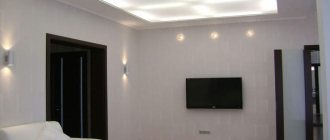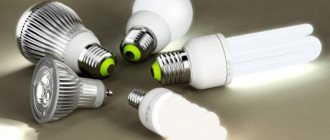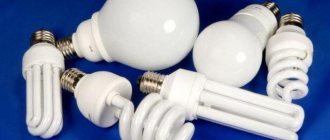LED light sources are safe and economical. Such lamps have a chip to which two semiconductors are connected - through them, electric current is supplied to the built-in crystal to produce light. This method leaves behind unsafe and energy-consuming incandescent lamps, as well as mercury and energy-saving lamps, which contain components harmful to nature. LEDs also lead in durability - they do not need to be replaced for years. That is why they are increasingly being used as the main source of light in apartments, private houses, offices, enterprises, and are used for decorative lighting and lighting of advertising signs.
The main advantages of LED lamps:
- do not heat up and are fireproof;
- When turned on, they immediately give off a bright light;
- provide a uniform glow without flickering;
- 5-10 times more economical than incandescent lamps;
- service life is up to 50,000 hours;
- large selection of standard sizes;
- ability to control the intensity and color temperature of light.
Find out moreBut there are also negative aspects. Perhaps the most significant disadvantage of LED lamps is the cost. But in comparison with the price of halogen and energy-saving ones, the purchase costs will be approximately the same. But during operation you can save on energy consumption and lamp replacement.
Glow color
LED lamps, unlike incandescent lamps, can have different glow colors. Therefore, it is important to decide which color is suitable and comfortable for you.
Warm or cold. If everything is more or less clear with warm light, it corresponds to a color temperature from 2700 to 3000 Kelvin. This is very similar to the lighting from a regular incandescent light bulb. More details
With cold colors everything is more complicated. There can be two types of cold flowers:
- natural or neutral white 4000-4500 kelvin
- daytime from 6000 to 6500 kelvin
The higher the color temperature, the more lumens the LED produces and, accordingly, the brighter the lamp shines at the same power.
The difference can reach 10-15%. Therefore, it seems to be more profitable to buy fluorescent lamps. You get more light for the same money.
However, can you rest and relax at home under the bluish, cold light that resembles the lighting in an operating room? Most likely no.
It just so happens that people find warm light more pleasant, such as from incandescent lamps or a fireplace. But at the same power, it is the least bright.
Therefore, the most popular is neutral or natural white 4000 - 4500K.
Price
Free cheese, as they say, only comes in a mousetrap. Good ice lamps, made of high-quality materials and in full compliance with the technological process, cannot be cheap. It is the high price that discourages consumers from purchasing. After all, you will agree that it is psychologically very difficult to pay more than 500 rubles for one lamp.
Consider purchasing such a lamp as a long-term investment. A good LED lamp will delight you with bright light for many years.
Supply voltage
There are lamps that are produced only for 220 volts:
- models with G9 base
- reflector lamps R39, R50, R63, R80
And there are models that are available for both 12 volts and 220V. Moreover, their shapes are almost identical.
- capsule G4
- reflector MR16 with GU 5.3 base
- GX 53 tablets
Conclusions and useful video on the topic
Companies holding leading positions in the lighting equipment market in the segment of household LED elements. The main pros and cons of branded products:
What mistakes do customers make when purchasing LED products? How to avoid them and purchase the right LED products that will work long and reliably. Reminder for potential buyers:
We can talk for a long time about which types of modern LED lamps are better. There is no clear answer to this question. It all depends on the purpose of the lighting system and the area of its use. Based on these parameters, it is worth choosing a suitable LED product.
There is no need to purchase nameless products in order to save money. It makes more sense to choose a module from a trusted brand that has proven itself well in the market.
Do you have anything to add or have questions about choosing LED lamps? You can leave comments on the publication, participate in discussions and share your own experience of using LED lamps. The contact form is located in the lower block.
Power
In recent years, there has been a misconception that the brightness of LED light sources is comparable to conventional incandescent lamps in a ratio of 1 to 10.
That is, if you need to replace a 100W light bulb, all you need to do is find a 10W LED model. Then it will give the same amount of light and you will not lose in brightness.
In fact, this is far from the case. A lot depends on:
- shapes - for example, reflective gives directional light, while pear shapes scatter it more
- flasks – matte or transparent
- scattering angle
- glow colors
At the same time, do not forget that each lamp shape has its own optimal power.
- for a ball or candle it is 5-6 W
- for pear or tablet GX 53 from 8 to 10W
- for MR16 reflectors this is 4-5W
- for capsules with G9 socket 2-2.5W
Exceeding these recommendations entails either an increase in size or a sharp reduction in service life.
Therefore, the optimal ratio of power equivalence between LED types and simple ones is 1 to 8.
If you do not have enough light, then you should not chase more powerful lamps. It would be best to add a couple of additional lamps.
Types of LEDs used
Additionally, the devices differ from each other in the type of diodes installed in the lamp body.
indicator elements are considered obsolete and are extremely rare in everyday life. The quality of the light output and the overall safety of these products do not meet the requirements accepted today.
SMD chips are the most common and most widely used type. The minimal size and low base heating of the working elements make SMD lamps the most attractive among analogues.
Their use has no restrictions and is allowed in any systems and conditions.
The only disadvantage of SMD-type diodes is their small size. Because of this, you need to install them in a light bulb in large quantities, and this is not always convenient or advisable.
Units operating on high-power diodes of 1.3 and 5 W can be very productive in some situations.
But the high level of heating during operation and the difficulty of organizing correct heat removal from a small case significantly reduce their popularity.
If any problems arise with the light bulb, it is not necessary to immediately run to the store and demand an exchange or refund. Simple problems can be easily fixed at home, even by craftsmen who do not have much experience in such work.
COB diodes are an innovative chip manufacturing technology. It is being developed very actively now. Due to direct mounting of diodes on the board, heat dissipation increases significantly, and the overall reliability of the device increases.
Thanks to the improved optical system, the light flow is distributed more evenly and creates a pleasant background glow in the room.
Filament is a progressive type of chip, invented in 2013-2014 by a group of scientists. Intended for lighting purposes only.
It is fully used for arranging original and unusual decorative lighting for domestic and industrial premises for various purposes.
A light bulb with filament-type diodes has all the useful features characteristic of LED sources. It looks stylish and attractive, lasts a long time, consumes a minimal amount of energy and provides uniform illumination of the room within a 360° radius.
Provides a spectrum of light that is pleasant to the human eye, similar in characteristics to the burning effect of a traditional incandescent lamp. In this parameter it is many times superior to similar SDM and COB type products.
In company stores it is sold at a reasonable price and is considered a practical option for an economical light source.
Flask
Which lamps are better - with a matte or transparent bulb? The LED is a point and very bright light source. If the lamp is visible in a chandelier or lamp, for example it is directed downward, then with a transparent bulb an irritating effect may occur, similar to a welding arc.
However, the matte diffuser does not have this drawback. Decide what is best for you - even, soft and diffused light, or very bright.
An exception is crystal chandeliers and similar lamps.
For them, point and sparkling light sources are better, which give a play of light on the edges of crystal elements.
What's glowing there?
In 1923, Soviet physicist Oleg Losev discovered electroluminescence of a semiconductor junction. The first LEDs using this principle were called “Losev Light”. The red LED was the first to appear, followed by yellow and green LEDs in the early 70s. The blue LED was created in 1971 by Yakov Panchechnikov, but it was extremely expensive. In 1990, Japanese Suji Nakamura created a cheap and bright blue LED. Even 20 years ago it was believed that it was impossible to create a white LED, however, after the advent of the blue LED, it became possible to make white light sources with three crystals (RGB). In 1996, the first white phosphor LEDs appeared. In them, ultraviolet or blue LED light is converted to white using a phosphor. By 2005, the luminous efficiency of such LEDs reached 100 lm/W or more. This made it possible to start using phosphor LEDs for lighting, because the LED is one of the most economical light sources.
Dimming
Controlling the brightness of lighting using a dimmer is a very useful and convenient feature. However, most LED lamps do not support this feature.
Finding a dimmable LED lamp of the desired shape, size, power and color is not easy and is almost always expensive.
It should be taken into account that dimming occurs by controlling the frequency parameters of the supply voltage.
And this will definitely cause pulsation on the lamp.
If you don't want ripples, skip dimming.
You can control the brightness in another way - by turning various lighting groups on and off.
Although this is less elegant, it is more effective and safer for your health.
Are LED and energy-saving lamps the same thing? And if not, which ones are better?
Of course, LED lamps can be considered energy-saving, however, in Russian the word “energy-saving” is assigned to compact fluorescent lamps (CFLs), and CFLs and LED lamps are completely different things.
LED lamps are much better than CFLs for several reasons:
• an LED lamp does not contain hazardous substances, and the bulb of any CFL contains mercury; • LED lamp consumes less energy with the same luminous flux; • the LED lamp instantly lights up to full brightness, and the CFL smoothly increases brightness from 20% to 100% per minute at room temperature and much more slowly at low temperatures; • CFLs have a poor spectrum consisting of peaks of several colors. The spectrum of an LED lamp is much closer to natural light and incandescent light.
Ripple
How do you know if a lamp has pulsation? Every major store has the ability to check product functionality.
Turn on the light bulb and just look at it through your mobile phone camera.
If there are stripes on the screen, the lamp is pulsating.
It is not advisable to use such products in residential premises. Their purpose is to illuminate entrances, garages, corridors and utility rooms.
If there are no stripes, then the lamp does not pulsate.
How not to make a mistake with the choice?
Many are tormented by the eternal question of which LED lamps are best to choose for personal use. The choice of lighting, for example, for a home, has its own characteristics and pitfalls. The main requirement is that the lamps should not cause discomfort to the eyes during prolonged use. There is nothing complicated in the selection process; when choosing a lamp, you just need to follow a few simple tips and rules.
Let's look at what technical characteristics of lamps you need to pay attention to when choosing lighting for rooms.
Quality
Let's say you have decided on all the above points. How can you tell a high-quality light bulb from a low-quality one?
If the lamps are the same in power and size, do not have pulsation and are very similar in appearance, then its weight can be considered an indirect sign of quality.
Estimate the weight in your hands or compare the data on the packaging. The lamp whose weight is greater is potentially better. More weight is a sign of a more massive cooling radiator.
Better heat dissipation means longer service life. If the product is powerful, but at the same time “weightless,” then this is a clear sign of a short-lived product.
Current manufacturers and models
Leading positions in the market segment of LED equipment and related elements are occupied by European concerns Philips and Osram .
They offer the client the widest range of certified products that meet all the most stringent international requirements for the quality of light sources.
LED lamps from Phillips and Osram are considered to be among the most reliable; they can withstand intense operating loads and fill rooms with pleasant light that is not irritating to the eyes.
Products from Russia demonstrate normal quality at a low price. The line of LED products includes lamps of various configurations, including modules designed for installation in furniture.
Ice lamps produced under the Gauss . The brand sells both budget and premium modules and provides a 3-year warranty on its products.
For an LED lamp to live up to your expectations, you should buy it not at the market or a table near the metro, but in specialized brand stores. This will help protect against defective or downright low-quality products.
The Russian company Era is a newcomer to the LED market, however, its consistently high-quality products have already attracted the attention of clients.
Now the company is actively developing production and in the future it plans to squeeze out competitors and even get ahead of them in the battle for buyers.
Life time
Each manufacturer indicates the service life on the packaging. However, even famous brands do not indicate periods of more than 25,000 hours of operation.
If on average a light bulb shines for 5-6 hours a day, then that’s already more than 10 years!
When the packaging states operating times of 30,000 or 50,000 hours, and the manufacturer’s warranty is only 12 months, then it’s clearly worth thinking about.
Color rendition
The parameter is designated CRI and determines the clarity and realism of the surrounding colors. Naturalness increases with increasing indicator.
For residential premises, values from 80 are recommended.
Lumens
On the packaging of LED products, manufacturers often indicate the illumination in lumens and what kind of conventional light bulb this corresponds to. How to correctly understand such inscriptions?
100W incandescent lamps produce a minimum of 1200 - 1300 lumens. If it is written on the packaging that a 10W light bulb produces more than 700 lumens and at the same time is the same as a simple 100-watt light bulb, then this is a clear sign of deception.
Study the table of correspondence between different types of lamps with their power and output lumens, and check the declared data from class=”aligncenter” width=”720″ height=”615″[/img]
If it doesn't work, just don't buy it. If it is close to the specified parameters, then the lamp should be of high quality.
Photo of LED lamps
Read here! LED lamps: detailed description, application features and review of the best manufacturers
Flaws
- High price. The price level depends on the brand; high-quality European products are much more expensive.
- Most often there is no brightness adjustment; this function is present only in expensive models and allows you to change the power.
- LEDs begin to fade over time, causing the brightness to noticeably decrease.
- The flickering effect is found in cheap products from Asian manufacturers.
Base
One of the main elements of any type of lamp is the base. Its main role is to install it in a cartridge and tightly hold the bulb that supplies the light flux. Through the base, electricity is supplied to the light converter.
Lighting devices are divided into energy efficiency classes. This is precisely why the types of socles were initially classified according to this criterion. LED devices - analogues are made according to this feature. In order to change the lamp to a new one, you just need to understand what type of base is needed.











